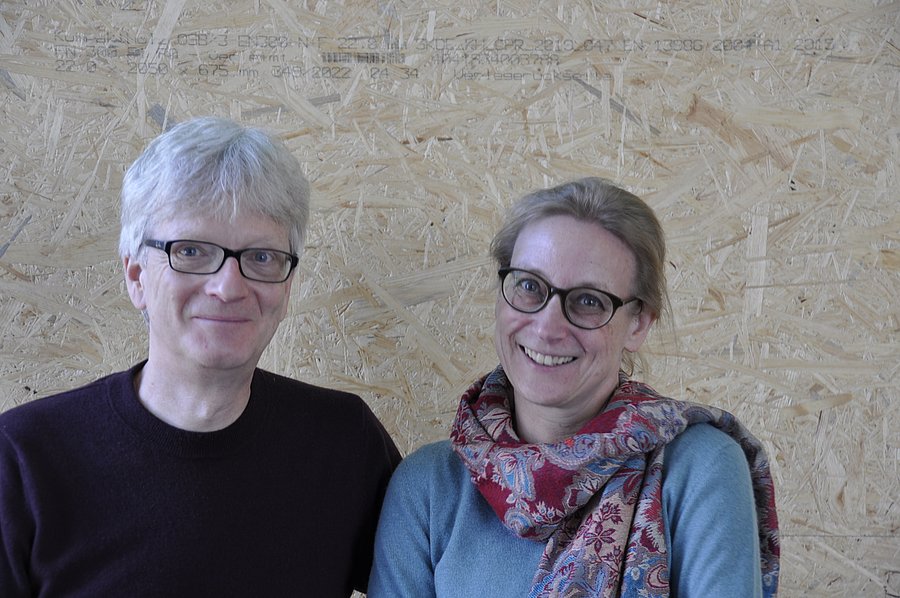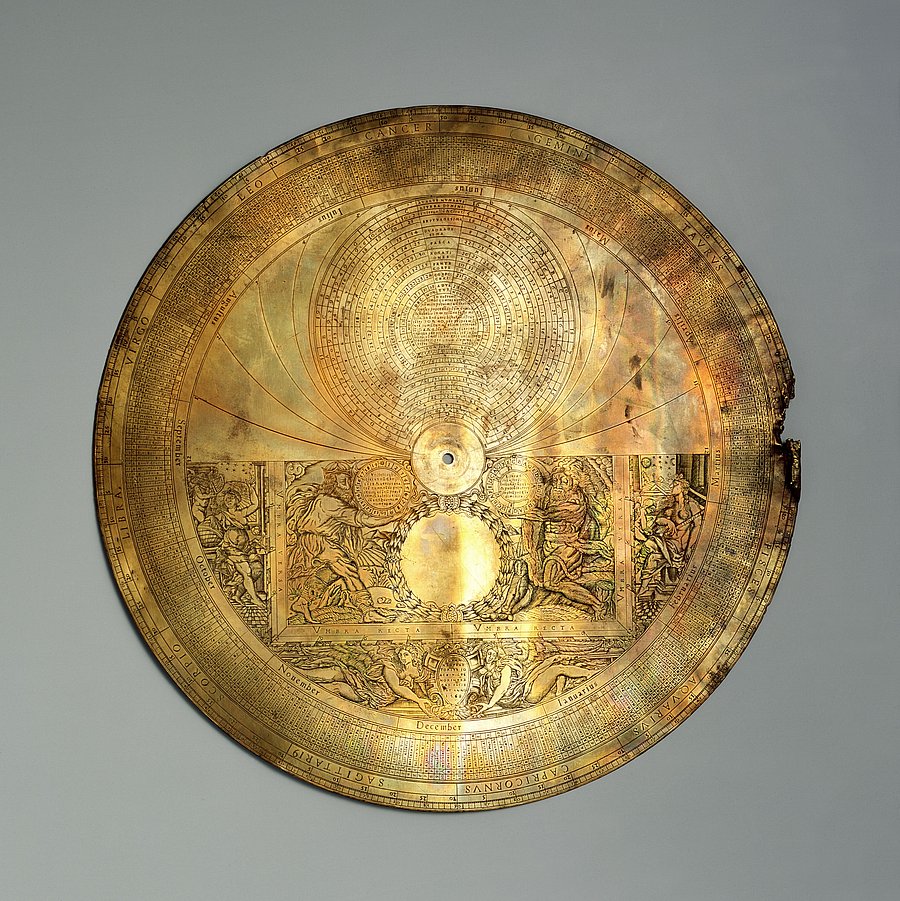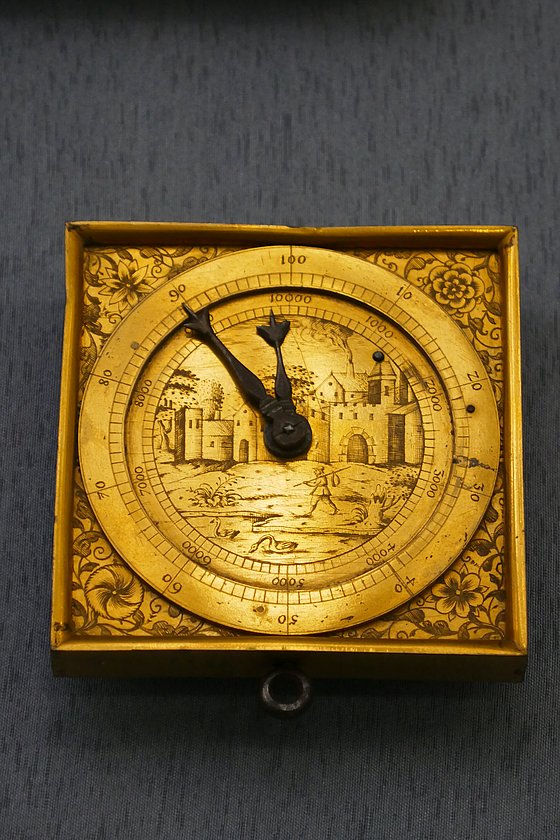
The mysterious imagery of scientific instruments
Prof. Dr. Volker Remmert and Dr. Julia Ellinghaus / History of Science and Technology
Photo: UniService Transfer
The mysterious imagery of scientific instruments
Prof. Dr. Volker Remmert and Dr. Julia Ellinghaus research scientific instruments of the early modern period
Fascinating names such as astrolabe or torquetum describe scientific instruments of the early modern period. Over the past centuries, scientists have repeatedly studied their function. Until now, their elaborately designed, mostly filigree pictures, which decorate their backs or their corpus, have remained largely unnoticed. Dr. Julia Ellinghaus and Prof. Dr. Volker Remmert from the Department of History of Science and Technology at Bergische Universität are studying this mysterious world of images on scientific instruments of the 16th and 17th centuries in a project funded by the DFG (German Research Foundation).
A museum visit with consequences
Volker Remmert had the idea for this project after visiting the Dresden Zwinger with its collection of historical instruments and looking at an astrolabe (an astrolabe is a disc-shaped astronomical calculating and measuring instrument. Editor's note), he noticed that the intricately crafted, mechanical device also offered an interesting back side that science had not really looked at before. "You always look at the front, with the scales and numbers for use, but there's always room for something else at the back. Unfortunately, because it was poorly displayed, I had a photo sent to me and realized it had Atlas and Hercules on it." The scientist immediately thought of the legend that says Atlas was the first teacher of astronomy and Hercules was his first student, taking the globe from the teacher. "That's when you suddenly see that these instruments are showing something that is not actually needed for technical operation," he says. Upon further research, he then discovered that no one has yet systematically dealt with these pictorial worlds - which are often engraved, but also sometimes painted or applied in a different technique. "In the older exhibition catalogs, there's always the functional front, and there's no photo of the back, because the collection makers and curators weren't that interested in it."
To change this, the scientist looked for collaborative partners, which he found in working with the Mathematical-Physical Salon in Dresden, the Astronomical-Physical Cabinet in Kassel and the History of Science Museum in Oxford. Together they prepared the application for the German Research Foundation. The team quickly parted ways with the initial idea of a cabinet exhibition, and travel to examine exhibits on site also became impossible due to the corona pandemic. "Sometimes you imagine things that then don't come about that way," Remmert explains, but "digitization helps us a lot there, and the databases with the digitized material were a lifesaver for us."

Astrolabe Johannes Prätori: Mathematical-Physical Salon, Dresden State Art Collections; Photo: Michael Lange
Objects of desire
A variety of scientific instruments show a world of images that provide information about the life and work of the past. These instruments are considered materialized and formed ideas. "In the late 16th and early 17th centuries, a great many instruments were invented, including instruments we still know today," Ellinghaus says. "These are telescopes, microscopes, but also thermometers and barometers that we use today as a matter of course. You can then divide those into optical or meteorological instruments." The two scientists were particularly interested in mathematical and astronomical instruments that could be used to measure the landscape or the sky. "There would be the astrolabe, this disk that looks very complicated and with which you can measure the position of the stars," she enthuses, "or the torquetum (A torquetum is an astronomical instrument that can determine the coordinates of a celestial body. Editor's note) as well as sundials and wheel clocks that come up and are beautifully decorated during this time."
A 16th-century smartphone
"It's also exciting to know," Ellinghaus continues, "that pedometers already existed at the time. You think today that only my super watch can do that, but no, that also existed back then. You hung a small device with a string on your belt and attached a small thread to your foot, which hung on a spring and counted every step as you walked. Of course, that was only for rich people. Or the smartphone of the 16th century. There are astronomical pocket sets, they then have a sundial, tables where they can set altitude and latitude, so they can use the thing when they're traveling. They have a lunar clock so they can tell time at night. The thing is really small and just flips open."

Historical pedometer: Photo: Julia Ellinghaus
Inventory
First, however, the scientists had to find and sift through the abundance of exhibits. Ellinghaus explains: "We looked at catalogs of collections that we know of that have many of these instruments, as well as special exhibition catalogs. We combed through the research literature and, of course, have a great resource in the form of databases on the web. Dresden, Oxford and Florence even already provide an extra database for their scientific instruments. Then you also immediately have the photos and a description for them." In many cases, of course, the surviving exhibits belonged to an upper class, such as automaton figures, which then moved inexplicably, seemingly magically, on the princely tables and amazed the guests. These objects were, of course, collectors' items even back then. "A torquetum made for a doctor stood safely in the practice for all to see and signified to the people that this doctor knew his trade, because bloodletting was targeted via the position of the stars and the calendar. Only if the constellation was correct, the moon had its position, was treated accordingly, and the physician had thus idea of the cosmos" explains Ellinghaus. But the two scientists are also familiar with paper and wooden instruments that were also decorated.
Ellinghaus and Remmert move with their research thereby in a little illuminated zone of the science. "Most of the time, these instruments are in museums of technical history, where the experts for scientific instruments are located, who are, of course, primarily interested in the functionality of these instruments," says Ellinghaus, "There, the scales are then examined and one looks at how precisely one could calculate with these instruments. And the art historians say, well, this is a utilitarian instrument, I'm not interested in the picture on it." The two scholars see it differently, they say, because many of these utilitarian objects are highly decorated and display imagery aimed at specific users. "We are investigating what this decoration, beyond language, wants to communicate to the user," she explains, and that is often not obvious and must first be opened up. In the case of Atlas and Hercules mentioned at the beginning, this means, Ellinghaus explains, "if I depict them, I show what a long tradition astronomy has and what mythical and royal figures it draws on. By doing that, people then put themselves in that line as well." Other illustrations also functioned as abbreviated instructions for use, proving the usefulness of an instrument. Many things that seem secret to us today, Remmert adds, were well known to people in the 17th century and would have to be rediscovered today.
Iconography - the interpretation of the content of works of art
Iconography on scientific instruments thus has a special significance. "Iconography is, after all, a term that many people are not familiar with," says Ellinghaus. "It's a method of art history: instead of talking about the style of a work of art, we talk about the content. It's about interpreting the content of artworks." A frequently recurring motif is the biblical story of King Hezekiah, who is sick to death in bed and is told by the prophet Isaiah of God's decision that he may live on for a few more years. "We find this scene several times on instruments. In an iconographic study, I then look at: how is this scene depicted." On a clock, for example, the entire story is compressed into just one image, while on a torquetum it is described in four detailed scenes. While the king is still in the foreground on the clock, the emphasis on the astronomical instrument changes in favor of the prophet and shows that healing is only possible through divine power, with man being the extended arm of God.
Remmert cites another example from the mathematical-physical cabinet in Kassel. "There is a not particularly large astronomical clock there by the Swiss clockmaker Jost Bürgi. There, on four sides of the clock, are eight stations from the history of geometry and astronomy. This starts with Adam and his son Seth as well as Abraham and goes up to Copernicus via Greek astronomers and mathematicians (e.g. Archimedes and Prolemeus) and Alfonso of Castile as a historical development. Thus, the relevance of this knowledge is also once again staged in a line of tradition that is also Christian."
Center of production: southwestern Germany
"It's quite interesting," says Remmert, "most of the instruments we were able to look at actually come from southwestern Germany," and Ellinghaus adds, "We also looked internationally. But most of the decorated instruments come from Augsburg or Nuremberg. Those are the cities for arts and crafts in this period; that's where the engravers, the clockmakers, but also just the artists who make the beautiful cases are located."
Dresden, Kassel and Hamburg are museum cities that still exhibit a variety of scientific instruments. But you can also find one or two in NRW. "The Arithmeum in Bonn is certainly a good address," concludes Ellinghaus, "they even had an interesting exhibit from Hamburg on display a few years ago. In Bielefeld, there is also the Museum Huelsmann. They have a large collection of applied art and obviously a lot of instruments, including decorated instruments." Wuppertal, she regrets, would also have been a great address if not for the wonderful Abeler Clock Museum, which closed a few years ago. "That was really one of the most renowned watch collections in the world, and Jürgen Abeler is also highly regarded in the watch literature."
Uwe Blass
Prof. Dr. Volker Remmert studied history and mathematics in Freiburg, Zurich and Karlsruhe. He habilitated in Modern and Contemporary History as well as in the History of Mathematics and Natural Sciences. Since 2011, he has been a professor of the history of science and technology at Bergische Universität. In addition, he heads the Interdisciplinary Center for Science and Technology Studies there.
Dr. Julia Ellinghaus is a research associate for the history of science and technology in the Faculty of Intellectual and Cultural History at Bergische Universität.
